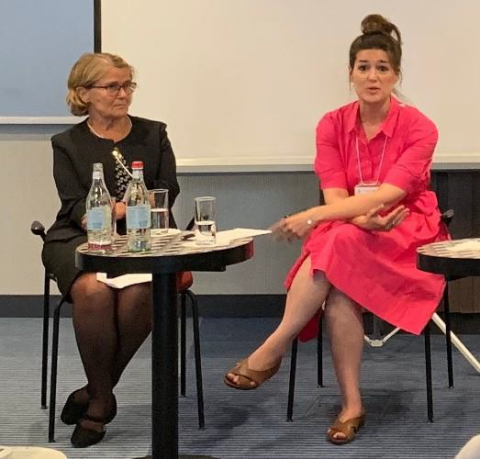
GCED Basic Search Form
Quick Search
You are here
News

6th meeting of the Technical Cooperation Group on the Indicators for SDG4-Education 2030 (TCG)
The UNESCO Institute for Statistics (UIS), in partnership with the Republic of Armenia Ministry of Education and Science, organised the 6th Meeting of the Technical Cooperation Group on the Indicators for SDG4-Education 2030 (TCG6). The meeting brought together key stakeholders in the field of education statistics to continue the development and implementation of the SDG 4 Monitoring Framework. ASPBAE’s Rene Raya participated in the meeting, filling in for the Latin American Campaign for the Right to Education (CLADE) who is the full CSO member of the committee representing the Collective Consultation of NGOs on Education 2030 (CCNGO/ED 2030). Also, in attendance from the Asia Pacific region were representatives from Bangladesh, Indonesia, People’s Republic of China, the Korean Educational Development Institute (KEDI), and the Southeast Asian Ministers of Education Organization (SEAMEO).
Silvia Montoya, Director of UNESCO Institute for Statistics (UIS), formally opened the Sixth TCG meeting with an update on the global progress of SDG 4. The meeting comes at a crucial time when the SDG indicator system is in the process of a comprehensive review that will culminate in the adoption of an updated SDG global indicator framework by the UN Statistical Commission during its 51st session in March 2020.
The discussions at TCG6 meeting focused on additional indicators; indicator development, reporting and benchmarking processes; and challenges and obstacles countries face in producing and reporting on SDG 4 indicators. The aim of the meeting was to review and endorse the methodological developments including on potential new indicators; review and finalise the list of indicators to be published in 2020; discuss and update, if necessary, the SDG data validation process; agree on the process to develop benchmarking for at least three selected indicators; and identify areas for improvement in data production and funding. It was noted, however, that additional indicators will be considered only in a few selected cases, particularly when there is a need to cover a critical aspect of the target that is not adequately captured by other indicators.
ASPBAE’s Rene Raya raised the absence of a specific indicator to measure a critical target under SDG Target 4.1 on free and compulsory basic education, noting that poverty, exclusion and the rising cost of education are the main reasons for dropping out or being pushed out of school. This was acknowledged, although coming up with an additional indicator for SDG 4.1 may be difficult at this late stage of the review process. Manos Antoninis of the Global Education Monitoring Report mentioned that this may be captured by the indicators under Target 4.5, particularly on parity indices and on extend to which explicit formula-based policies reallocate education resources to disadvantaged populations.
The TCG was formed in early 2016 to lead the development and implementation of the global and thematic indicator frameworks to monitor the education targets in SDG 4. It is currently composed of 27 Member States and 8 organisations including representatives of all regions as well as from civil society and international organisations, such as CCNGO/ED 2030, Education International, OECD, UNICEF, the World Bank, and UNESCO itself.
6th meeting of the Global Alliance to Monitor Learning (GAML)
An earlier meeting that focused on learning outcomes was also organised by the UNESCO Institute for Statistics (UIS) in Yerevan. This meeting was attended by additional participants including representatives from other countries such as Afghanistan and other CSOs. ASPBAE member, Campaign for Popular Education (CAMPE), also attended the meeting and was represented by its Deputy Director, K.M. Enamul Hoque.
The meeting looked specifically on the methodology and progress for the following indicators:
Indicator 4.1.1 – on minimum proficiency level in reading and mathematics
Indicator 4.4.2 – on minimum level of proficiency in digital literacy skills
Indicator 4.6.1 – on level of proficiency in functional literacy and numeracy skills
Indicator 4.7.4 – on understanding of issues relating to global citizenship and sustainability
On the methodology for measuring learning outcomes, Rene raised the question whether the learning assessment modules that have been developed were also applicable to out-of-school learners taking up alternative learning courses, and to persons with disabilities. Rene noted that the assessment modules were focused only on the learning achievements of students in a formal school setting. The panelist from UIS and USAID, among others, responded that the assessment modules also considered learners outside the school system and that the same modules can be applied.
On proficiency in digital skills, CAMPE’s Enamul Hoque raised the issue that developing countries such as Bangladesh are struggling to provide ICT systems and facilities given limited resources and the persisting low investment in education. Enamul stressed the need to strengthen global partnership to address the widening digital divide and ensure that all equally benefit from innovations and advances in digital technology.
The meeting was a good learning event for the participants. The UIS, development agencies and regional organisations shared learning assessment frameworks, modules, data generation systems, evidenced-based policy making and capacity development initiatives. It is significant to note the progress made in developing the framework and methodologies for assessing literacy and numeracy. It is also worth mentioning that a number of assessment tools are now looking at the broader concept of learning that includes global citizenship, sustainability, and social relations in an increasingly diverse world. In the Asian region, for example, the Southeast Asia Primary Learning Metrics (SEA-PLM) was jointly developed by SEAMEO, the UNICEF Regional Office for East Asia and the Pacific (EAPRO) and countries from the Association of Southeast Asian Nations (ASEAN). The assessment metrics measures student performance on four domains: reading, writing, mathematics, and global citizenship.
The UIS is also proposing a new indicator on “Breadth of skills” which will assess the extent to which national education policies and education sector plans recognize a breadth of skills that needs to be enhanced in national education systems.
URL:
http://www.aspbae.org/userfiles/sep19/others/ASPBAE_Bulletin_July-August_2019.pdf
